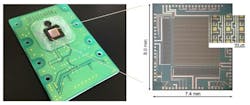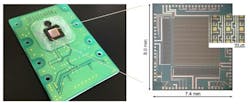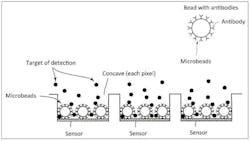CMOS imaging biosensor could enable early diagnosis of diabetes, Alzheimer's
Researchers at the Toyohashi University of Technology and the National Center for Geriatrics and Gerontology (Toyohashi, Japan) have developed a semiconductor-imaging biosensor that analyzes blood and urine for early detection of diabetes and Alzheimer's diseases, among others.
Related: Portable, low-cost fluorescence biosensor diagnoses Type 1 diabetes early
The biosensor comprises a 128 × 128-pixel complementary metal-oxide semiconductor (CMOS) image sensor developed at the Toyohashi University of Technology that is sensitive to extremely small changes in electric potential, and microbeads on which antigen-antibody reactions take place. This technology will enable monitoring and diagnosis of diseases for which specific markers are known using very small volumes of blood or urine. Specifically, this technology has detected amyloid beta-peptide, an agent responsible for Alzheimer's disease.
Contracting a disease leads to expression of proteins specific to the diseases in the blood. This new technology is used for early diagnosis of diseases by using this specific protein as the antigen and a marker that captures the protein as the antibody and checking their antigen-antibody reaction. Conventional protocols used to monitor antibody-antigen reactions employ fluorescent probes and detection of fluorescence with microscopic cameras. This process is time-consuming because of the necessity to measure fluorescence from the probes and the fact that it cannot be used to detect low concentrations of antigens when the fluorescence intensity is too low to detect optically.
With this technology, a antigen-antibody reaction is used as in conventional methods, but fluorescence is not measured. Instead, this method employs a semiconductor image sensor to detect minute changes in electric potential generated during an antigen-antibody reaction.
Implementation of the technology will be tested for daily control of lifestyle diseases such as diabetes, with plans in the future to be expanded to early diagnosis of Alzheimer's and Parkinson's diseases.
Full details of the researchers' work appear in the journal Sensors and Actuators B; for more information, please visit http://dx.doi.org/10.1016/j.snb.2014.04.019.
-----
Follow us on Twitter, 'like' us on Facebook, and join our group on LinkedIn
Subscribe now to BioOptics World magazine; it's free!


